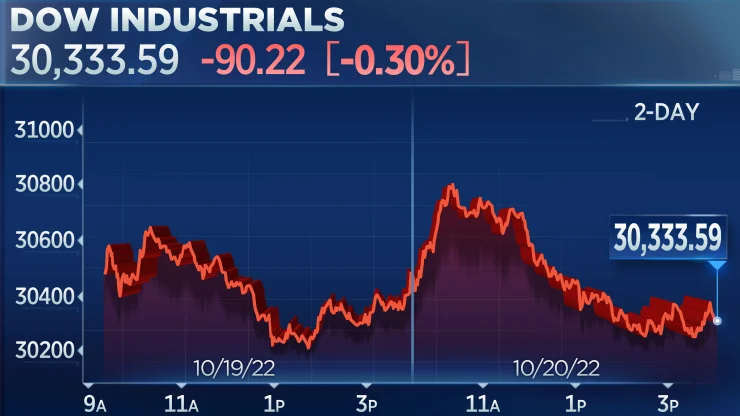Stocks fell in choppy trading on Thursday as investors weighed several key earnings reports and kept an eye on the bond market, where Treasury yields continue to climb.
The Dow Jones Industrial Average slipped 90.22 points, or 0.30%, to 30,333.59. The S&P 500 fell 0.80% to 3,665.78. The Nasdaq Composite shed 0.61% to close at 10,614.84. The Dow was up nearly 400 points at session highs, but stocks faded as Treasury yields rose.
The benchmark 10-year Treasury yield reached a high of 4.239% on Thursday, trading at levels not seen since 2008. Rising rates have been a headwind for stocks all year, as the Federal Reserve continues to try and cool off inflationary pressures not seen in decades.
“As long as official policy is to make the stock market go down, so that people are less wealthy, so that they buy fewer things, so that prices stop going up, all while doing nothing about fiscal policy, we believe the correct posture is to be bearish on stocks and bullish on inflation,” Greenlight Capital’s David Einhorn said in an investor letter obtained by CNBC.
Stocks have declined for two straight days, but the major averages are still up more than 2% for the week.
Several strong earnings reports limited losses for the market, with AT&T and IBM rising 7.7% and 4.7%, respectively, after beating estimates on the top and bottom lines for their most recent quarter.
On the downside, Tesla shares dropped more than 6% after the electric vehicle maker said Wednesday evening it expects to miss its 2022 deliveries target. The company also posted quarterly revenue that missed analysts’ expectations.
The rising Treasury yield environment is one reason that many strategists are skeptical the market can sustain a rally in the near term, even though the third-quarter earnings season has been better than expected so far.
“Our guess is that earnings will be good enough to keep the market in a trading range, but not enough to send it back up to its midsummer high and given the lagged nature of monetary policy, we would argue that time is not on the market’s side. We would note that US rates continue to push out to new cycle highs, helping the USD trounce its peers,” Michael Shaoul of Marketfield Asset Management said in a note.
Indeed, the dollar hit its highest level against the Japanese yen since 1990 on Thursday.

